November 12th, 2010
Location Location Location
Digital place-based media and maximizing return on ad spending.
Running a TV ad in the supermarket aisle when the customer is finalizing their brand selection is a no brainer. Digital place based media, or in-store digital, was originally designed to be one further push for the consumer at the point of purchase. It made perfect sense; consumers often enter a store without a firm brand selection in mind. Once in the store, the plethora of conflicting packaging and messages can be overwhelming.
Knock, knock. Who’s there? Place-based digital media.
In a store with a million brand choices, digital media is just the ticket to make a particular brand stand out in all the clutter – inspiring consumers to make that one right choice.
Knock, knock. Who else is there? Results.
According to a recent AdAge article, “Over the past decade, the store has become the single leading driver of awareness of new package-goods products, significantly passing TV.” A digital in-store message offers the best of both worlds – a timely message in a TV spot format that cuts through much of the overwhelming mish-mash of in-store promotion.
 The supermarket is a unique purchasing destination. Many of the products are commodity items that don’t enjoy unshakable brand loyalty. The products advertised are in a high volume retail environment and are the ones currently at the customer’s fingertips. This makes for the highest possible contextual combination, basically resulting in message targeting on steroids.
The supermarket is a unique purchasing destination. Many of the products are commodity items that don’t enjoy unshakable brand loyalty. The products advertised are in a high volume retail environment and are the ones currently at the customer’s fingertips. This makes for the highest possible contextual combination, basically resulting in message targeting on steroids.
Digital place-based media in supermarkets follows the golden rule of critical mass and efficient message targeting. A recent Arbitron study confirms that this strategy has successfully garnered high levels of unique visitors over a month for grocery stores (72 million). According to the study, 19 percent of those who saw an ad made an unplanned purchase.
 In addition to supermarkets, there are other types of retail that could take advantage of the “critical mass and efficient message targeting” rule, such as large department stores and malls. Study results show in high numbers of redirected, reinforced and even unplanned purchases among monthly unique visitors at large department stores and malls – 69 million and 70 million, respectively.
In addition to supermarkets, there are other types of retail that could take advantage of the “critical mass and efficient message targeting” rule, such as large department stores and malls. Study results show in high numbers of redirected, reinforced and even unplanned purchases among monthly unique visitors at large department stores and malls – 69 million and 70 million, respectively.
 The numbers are particularly impressive considering that visitors to these particular locations tend to move with purpose as opposed to other venues where there are captive audiences for extended periods of time, such as doctors’ offices. By the nature of these high traffic and high clutter venues, visitors are typically bombarded by a multitude of demands on their time and attention. A TV spot with eye-catching and compelling creative is proving to be a substantial means of garnering the consumer’s attention.
The numbers are particularly impressive considering that visitors to these particular locations tend to move with purpose as opposed to other venues where there are captive audiences for extended periods of time, such as doctors’ offices. By the nature of these high traffic and high clutter venues, visitors are typically bombarded by a multitude of demands on their time and attention. A TV spot with eye-catching and compelling creative is proving to be a substantial means of garnering the consumer’s attention.
 But not everyone looks to reach the audience that frequents supermarkets and malls. Venues that also enjoy a high volume of unique visitors are medical offices at 52 million unique visitors monthly, movie theaters at 50 million, gas stations at 43 million and Quick Service Restaurants at 42 million. In these venues, the messages vary from extremely targeted (such as selling diapers in an obstetrician’s office) to selling a mixed bag of loosely related products and services (such as advertising soft drinks at a gas station). In many cases, these products or services are not sold at the same place the video is viewed, thus removing the “path to purchase” from the actual purchase event and eliminating the impulse buy.
But not everyone looks to reach the audience that frequents supermarkets and malls. Venues that also enjoy a high volume of unique visitors are medical offices at 52 million unique visitors monthly, movie theaters at 50 million, gas stations at 43 million and Quick Service Restaurants at 42 million. In these venues, the messages vary from extremely targeted (such as selling diapers in an obstetrician’s office) to selling a mixed bag of loosely related products and services (such as advertising soft drinks at a gas station). In many cases, these products or services are not sold at the same place the video is viewed, thus removing the “path to purchase” from the actual purchase event and eliminating the impulse buy.
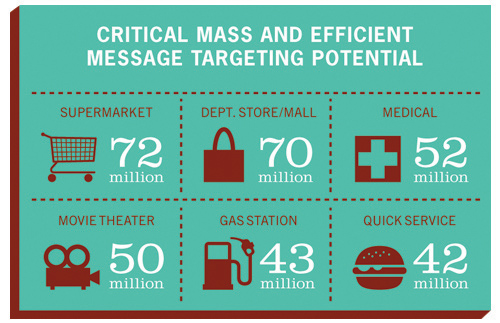
Where food store chains have stuck to a firm point-of-sale promotion to educate customers and introduce new products, they have enjoyed as much as a 46 percent increase in sales. Other marketers believe in more of a “Life Pattern Marketing”TM (SeeSaw Network) experience where the consumer can see the TV spot at home in the morning, again at the gas station, once more at their local gym and then finally at the point-of-purchase in the supermarket. They believe that the “psychological impact on a consumer getting the brand message in many contexts permeates the ‘noise’ and builds awareness and retention.” Brand ubiquity is a worthy but expensive goal. A far more challenging and rewarding goal is to create the perception of brand ubiquity – and that’s where true targeting replaces mass coverage.
If your product lends itself to a point-of-purchase digital experience and you create an engaging consumer message, an in-store program should yield a desirable return on your investment. If your experience is contextual but removed from point-of-sale, you stand to lose some momentum unless you’ve managed to create brand ubiquity and have your consumer locked and loaded.
November 12th, 2010
Innovate or Die
An Article About Neither
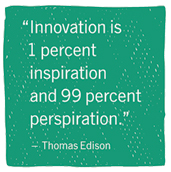 The editorial calendar for Thinking is set six months in advance. Writing assignments are then tracked by the working title of the article. On Wednesday evening (when this article was originally due), our editor reminded me that I had passionately pitched the provocative headline above, but of course I had not provided her an outline or abstract, so she had no idea what I had intended to write about. That made two of us. Her parting direction was highly motivating: “Something about innovation, no later than Friday morning. You are holding up the whole show.”
The editorial calendar for Thinking is set six months in advance. Writing assignments are then tracked by the working title of the article. On Wednesday evening (when this article was originally due), our editor reminded me that I had passionately pitched the provocative headline above, but of course I had not provided her an outline or abstract, so she had no idea what I had intended to write about. That made two of us. Her parting direction was highly motivating: “Something about innovation, no later than Friday morning. You are holding up the whole show.”
Thursday 7:55 a.m. 500 words about innovation. Should be a piece of cake and I have an easy day ahead, with only one scheduled meeting on my calendar. Let’s see, innovation: creativity, big ideas, thinking outside the box, reinvention, The Big Hunt. Maybe I will pull out the old “innovation go-to” case study on Post-It Notes or find a write-up about Apple. Foster a creative environment. Capture thinking from all levels of the organization. Reward risk taking. It’s all about ideation.
Thursday 8:04 a.m. The first new email of the day. I begin to respond via email and decide to pick up the phone instead.
Thursday 6:16 p.m. Three hours on the telephone, 166 e-mails (about 10 of which I really needed to be included on), someone “just stopping by” every time I sat down in my office, an impromptu meeting to discuss something about replacing the carpeting in the lobby (I was only halfway listening) and prepping a forecast that I forgot I had promised our bank. Heading out of Bozell, I see a text message waiting from my daughter that says, “Where r u? I have practice at 6:30.”
At least the only scheduled meeting of the day went well. Our senior team gathers every other week to discuss our strategic initiatives. We have tons of good ideas and many of them do not require a major investment to get off the ground. As a relatively small organization, our problem is time. The people who are serving our clients are the same people who are tasked with implementing new ideas. I offer a stellar update on the launch of the new business unit that we initiated about a year ago, though I don’t have much to report because I have been really busy lately.

Thursday 11:05 p.m. Still no article, but while I was watching the news I drew a really cool process diagram on how to spur creative thinking. Quick glance at my email. Interesting. Some survey(1) shows Fortune 500 executives rank their organizations as well above average in generating ideas, but very poor in commercializing them. Case studies on companies that struggled with execution even after big ideas were out in the open. Xerox after Canon introduced personal copiers. Kodak after digital photography was introduced. Sears after Wal-Mart introduced the everyday low pricing retail format. I guess big companies have the same problem getting stuff done as we do. I am going to go back and read it, just a soon as I come up with something to write about innovation.
“All talk and no walk” does not make for an innovative company. Those of you close to your customer and business know that ideas often flow freely, and the difficulty comes in bringing good ideas to commercial viability.
There will always be operational aspects of your business and interruptions that will impact priorities. To improve innovative execution, try:
Ranking ideas in a quadrant, comparing the highest business impact with ease of implementation, which based on your organization, may include impact on operations and funding requirements.
Assign a champion to each idea, giving that person both the responsibility and accountability to move the idea forward.
Assigned a timeline with measured milestones and phased spending limits.When milestones are reviewed, remember that invariably additional information will arise as an idea is tested. Also be cognisant that champions may lose objectivity as they invest their time and emotions into a project. Create a disciplined process to authorize continued resource allocation.
1. The Other Side of Innovation: Solving the Execution Challenge, Harvard Business Press, September 2, 2010, Vijay Govidarajan and Chris Trimble.
November 12th, 2010
The Reshaping of Market Segmentation
Segmentation is at the heart of every marketing strategy. Consumer market segmentation is viewed as a “best-in-class” practice across the marketing world. An entire industry has grown around segmentation and clustering products and tools (think shotguns and pickups). And there is a constant drive to better segment our customer and prospect base because conventional wisdom holds that the better we segment, the better we can market.
The challenge is that the static definitions of consumer segments are becoming less reliable in our fast changing and volatile society, especially in today’s economic climate.
First, consumers are never just part of one segment. We’re complex beings by nature. Accountant by day, biker by night. Zealot sports fan on Sunday, kindergarten teacher on Monday. Consumers rightfully feel that they belong to a multitude of segments because they are multidimensional.
Secondly, external factors like the Internet and mobile connectivity influence the decision-making process by providing constant access to tons of information and people.
As a result, how we think about segmentation is being reviewed and reshaped on an ongoing basis. The fact consumers are segmenting themselves when participating in social networks provides a great opportunity for insights. Based upon their interactions, the different roles people can have in communities and the content which is generated by them can be analyzed to create a self-segmented model. So self-segmentation is quickly emerging as a viable and valuable segmentation approach.
The best way to think about the difference between traditional consumer market segmentation and self-segmentation is to think of segmentation as a behavior. Our traditional practice of market segmentation is the marketer’s segmenting behavior. That’s basically your partitioning as a marketer of your total market into segments. Self-segmentation is the consumer’s segmentation behavior.
The core axiom driving self-segmentation is that the customers (not the provider of a good or service) know best what they want.

 Offer your customers and prospects networking opportunities based on self-acclaimed interests. Use Facebook, LinkedIn or even consider creating your own community via Ning.
Offer your customers and prospects networking opportunities based on self-acclaimed interests. Use Facebook, LinkedIn or even consider creating your own community via Ning.
 Create correlations between purchased products and services, and serve them up as recommendations. Think about how Apple’s Genius service works — you like this, you might also like this.
Create correlations between purchased products and services, and serve them up as recommendations. Think about how Apple’s Genius service works — you like this, you might also like this.
 Make it easy to share content or feedback in the context of your brand. It can be as simple as incorporating the Facebook Like button on your website or elaborate as creating an entire sharing effort like the “Power of the Human Voice” campaign that Blue Cross launched to let consumers share their ideas about healthcare.
Make it easy to share content or feedback in the context of your brand. It can be as simple as incorporating the Facebook Like button on your website or elaborate as creating an entire sharing effort like the “Power of the Human Voice” campaign that Blue Cross launched to let consumers share their ideas about healthcare.
![]() Create ways that consumers can opt in to alerts by various interest categories or deal-driven options like Orbitz Fare Alert.
Create ways that consumers can opt in to alerts by various interest categories or deal-driven options like Orbitz Fare Alert.
While more and more companies are shifting some emphasis from brand-controlled segmentation to enabled self-segmentation, it doesn’t diminish marketers’ need to understand their consumer base and provide relevant information based on that knowledge.
Traditional consumer segmentation will continue to play a critical role in aligning media strategy and related intersection insights with the core segments of a particular brand, matching the right channel moment with the most appropriate segment and in identifying the right segment for a new product or product design.
A decade ago, Lewis and Bridger argued that a new type of consumer began emerging some 30 years prior. Christened “the New Consumer” (NC), today these NCs have established a firm foothold and are even more common than the Old Consumer. The NC is far more rational in terms of using up his/her resources, especially time, trust and attention. These resources have gained the same importance as money. This has a serious impact on marketing and segmentation. NCs are independent, informed, involved and individualistic. They are more independent in the sense that the simple cause and effect relationship between seeing an advertisement and then buying a product — much like a Pavlovian reflex — has been replaced by something like an ironic distance. The psyche of the individualist has freed itself subtly but decisively from the shackles of mass convention; the NC decides more or less autonomously and spontaneously which advertising message is used as a consumption trigger. She/he no longer needs the security of the group and instead values individuality.
November 12th, 2010
Changing Customer Perceptions
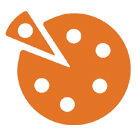 Tate & Lyle is one of the world’s leading providers of food ingredients. It literally supplies hundreds of different ingredients — such as sweeteners, starches, fiber and more — to leading food manufacturers such as Kraft and ConAgra.
Tate & Lyle is one of the world’s leading providers of food ingredients. It literally supplies hundreds of different ingredients — such as sweeteners, starches, fiber and more — to leading food manufacturers such as Kraft and ConAgra.
Most people who work in the food manufacturing industry know who Tate & Lyle is. However, because of its long history and respected reputation as a quality ingredient provider, many of those people also thought that they knew everything there was to know about the company.
Tate & Lyle wanted to change that. It was looking for a “wow” factor that would make customers and potential customers stop and say, “Maybe I don’t know everything there is to know about these guys.”
The International Food Technologists (IFT) Food Expo happens once a year. It’s like Disneyland for food technologists and research and development folks. It’s a packed house of food industry decision makers looking for inspiration and the next big idea. That makes it a great place to connect with existing and potential customers, but it’s also an overwhelmingly challenging place to find a way to stand out in the crowd.
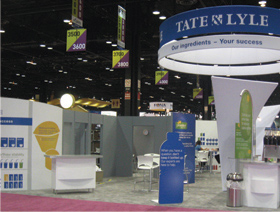 Tate & Lyle approached Bozell to develop a new approach for its entire presence at the IFT Food Expo. In the past, its exhibit design and messaging had been largely product focused — showcasing top-selling products such as SPLENDA® Sucralose and PROMITOR™ Dietary Fiber. It had seen success, but didn’t feel that it was truly communicating its innovative approach of going beyond just providing individual ingredients to providing complete customer solutions.
Tate & Lyle approached Bozell to develop a new approach for its entire presence at the IFT Food Expo. In the past, its exhibit design and messaging had been largely product focused — showcasing top-selling products such as SPLENDA® Sucralose and PROMITOR™ Dietary Fiber. It had seen success, but didn’t feel that it was truly communicating its innovative approach of going beyond just providing individual ingredients to providing complete customer solutions.
Using Tate & Lyle’s existing booth to maximize budget, Bozell created an entirely new platform for the IFT Food Expo. The theme “Our Ingredients — Your Success” focused on the partnership Tate & Lyle builds with each of its customers. The messaging reinforced Tate & Lyle’s proactive approach and ability to work with customers throughout the product development process to find the perfect solution to product challenges.
A fresh, contemporary design not only stood out from the more traditional look of other exhibitors, but also produced the backdrop for six stations featuring prototype products addressing the latest consumer trends driving new product innovation.
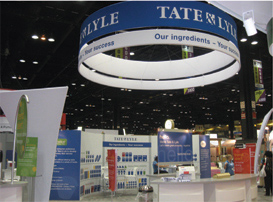 For example, one station featured the trend of healthier family snacks, and offered samples of no-sugar-added peanut butter cookies with 6g of fiber per serving made with SPLENDA® Sucralose and PROMITOR™ Soluble Corn Fiber. Another featured the trend of consumers’ increased desire for exciting new tastes and textures, and featured crunchy coated nuts made with PROMITOR™ Soluble Corn Fiber and X’PAND’R® SC corn starch to produce a light and crispy coating.
For example, one station featured the trend of healthier family snacks, and offered samples of no-sugar-added peanut butter cookies with 6g of fiber per serving made with SPLENDA® Sucralose and PROMITOR™ Soluble Corn Fiber. Another featured the trend of consumers’ increased desire for exciting new tastes and textures, and featured crunchy coated nuts made with PROMITOR™ Soluble Corn Fiber and X’PAND’R® SC corn starch to produce a light and crispy coating.
Tate & Lyle booth attendees received a punch card to track their visits to each trend station. Those who did were eligible to enter a drawing for an Apple iPad or iPod Touch. Pre- and post-show emails to attendees featured the same messaging as the booth and were designed to generate booth traffic (pre-show) and reinforce the booth message to maintain customer awareness (post-show).
The booth received heavy traffic throughout the show, and generated 270 leads for requests on specific product details and 35 requests for actual product samples. The client was exceptionally pleased with the creative approach and the finished product. Tate & Lyle’s mananging principal of promotion for the Americas, Stephanie Edgecombe, reported that the Bozell team “really helped us make great changes in the way we communicate…it was great to be amongst those who thought differently and gave me support to push forward new ideas within the organization. You’ve made a huge impact and it is recognized.”

November 12th, 2010
Love the Like Button?
 On July 21, Facebook finally surpassed the 500-million member mark. According to some web traffic monitors, Facebook is currently beating Google as the most visited website in the United States. Facebook’s power as a marketing and advertising vehicle can no longer be questioned. Today, Facebook is the web’s largest powerhouse of user-generated reviews and recommendations. Facebook users share more than 25 billion pieces of content a month. This content includes web links, news stories, blog posts, notes, photo albums and more.
On July 21, Facebook finally surpassed the 500-million member mark. According to some web traffic monitors, Facebook is currently beating Google as the most visited website in the United States. Facebook’s power as a marketing and advertising vehicle can no longer be questioned. Today, Facebook is the web’s largest powerhouse of user-generated reviews and recommendations. Facebook users share more than 25 billion pieces of content a month. This content includes web links, news stories, blog posts, notes, photo albums and more.
If only there was a way to take advantage of Facebook’s half a billion share-happy users to promote your website and your products without having to buy ads.
Well, now there is. At the most recent Facebook Developer Conference (F8) in April of 2010, Facebook launched the Like button. This button can be added to just about any website with one line of code. Once added, visitors to your site can click the Like button and automatically share your blog posts or products on their Facebook walls. This share, or Like, will then be seen by all of the friends of the person who clicked the button. This is no small group, considering that the average Facebook user has 130 friends.

The Facebook Like button is already being added to more than 10,000 websites per day. Many of them are already sharing their success rates, such as ABC News’ 190% increase and Sporting News’ 500% increase. Shortly after the Facebook Like button was launched, TypePad (a platform for bloggers) released a feature that enabled all their bloggers to attach a Facebook Like button to the bottom of each of their blog posts. To date, more than 2,400 bloggers have added the feature. TypePad has reported an average of 200 percent growth in referral traffic from Facebook.
So, you have to ask yourself as a marketer: when was the last time that an ad buy increased web traffic by that much?
Oh, and did I mention that the Facebook Like button is free?

Although the button is only a few months old, it is already working its way into web services beyond websites. Email marketing service MailChimp recently released a new version that allows users to add Facebook Like buttons to their email campaigns. At the MobileBeat 2010 Conference held in July, Facebook’s Head of Mobile Products, Eric Tseng, told conference-goers that they could expect to see the Like button go mobile very soon. This is not really a surprise considering that more than 150 million Facebook users connect via mobile devices.
The Like button is the simplest social plugin being offered by Facebook today. At the last Facebook Developer’s Conference, Facebook unveiled an impressive new set of API’s and social plugins that anyone can integrate into their site for free. The plugins range from the simple Like button to threaded commenting and live streaming chat; all hosted by Facebook. This effort by Facebook is good for users because it increases their ability to share with their friends. It is good for your business because it gives you access to easy user recommendations and more traffic. And ultimately, it is good for Facebook, as it makes them a portal to more of the web. These days it seems like Facebook doesn’t want to be the biggest social network on the web—it wants to be the web.
And it is off to a pretty good start. According to the latest statistics, the Like button is clicked about 65 million times a day.
June 28th, 2010
Dashboards
The next level of information efficiency.
As marketers in a modern digital world, we realize analytics are vital to operating our businesses and running our sales and marketing. If we can’t or simply don’t track our key metrics we will be slow or incapable of responding to problems with our services and processes or unable to capitalize on marketing opportunities.
One very effective way of tracking these metrics is through the development of marketing dashboards. When you compile your data into a useable format you will gain powerful insights into your business.
In a nutshell, a marketing dashboard is a report that pulls together the most important predictive metrics in a format that is easily understandable. Any kind of pertinent data you currently collect can be pulled into a dashboard to give you timely critical information. Whether you’re looking for seasonal purchasing habits of customers in a region or by market segment, this visual report can help your organization pull together information that helps you operate more efficiently and turn better profits.
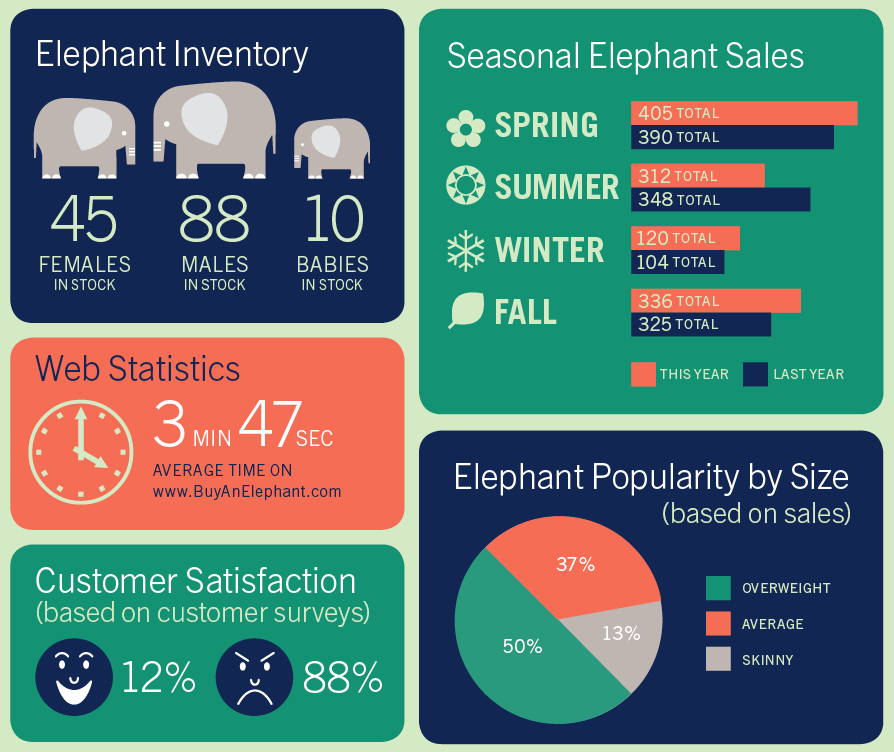
Here are some important considerations when designing a marketing dashboard:
- Get your executive team together and discuss the key metrics that will give the greatest benefit to the organization.
- Define marketing’s role in your organization. If you know that it is marketing’s responsibility to retain customers and improve customer experience, you know what metrics should be tracked to prove effectiveness.
- Determine the chain of data that can be linked between your marketing strategies, tactics, objectives and results.
- Develop a structure and design to the interface that is straight forward and usable by different individuals within your organization.
- Include financial statistics that will help to better track the return on marketing spends.
- Once you have completed the dashboard, continually review the data with your team and the executive group. Only through continued use will you be able to determine whether the dashboard renders the most appropriate information to help your organization make smarter business decisions.
If you are currently collecting these types of information but in disparate ways, then you are already a step ahead. It is now your opportunity to analyze this information and bring it together into a viable reporting solution. Start by reviewing all of your data sources then determine what key performance indicators you can glean from your data and decide upon the most useful format for presentation.
One important caveat is that the report should not be just a presentation of aggregated data. Even the most powerful information does little good without context. An upfront summary is critical to helping all members of your marketing staff understand how to read the data and why it is important.
At the end of the day, how does it affect the bottom line within your organization? Now more than ever, marketing has the opportunity to track and measure spending and usage habits of customers and prospects. And with the aggregation of these trends you have even more power to change your tactics as your organization makes operation changes or your customers and industry change.
June 28th, 2010
Differentiation through Design
40% Remember this number – it is important. It could mean the difference between big business and closing your doors.
Okay, here’s why:
People remember things they see 40% more than things they read or hear. And that’s exactly why companies have to have some sort of visual identity that sets them apart.
Creating an identity is one of the most important things in establishing any business. But defining an identity can be tricky.
 An identity is the graphic “face” of your business. A logo, brand colors, store design, these are just a few things that make up a whole identity. And making all of the elements work as one cohesive package could mean the difference between a forgettable company, and a memorable one.
An identity is the graphic “face” of your business. A logo, brand colors, store design, these are just a few things that make up a whole identity. And making all of the elements work as one cohesive package could mean the difference between a forgettable company, and a memorable one.
So having an iconic logo and strong visual consistency will greatly increase the chances that your company is remembered. The colors, fonts, and symbols you use in all your marketing materials can also communicate the essence of your company in a way that’s more powerful than using words alone.
Let’s look at Starbucks:
The lines at the counter are at least five people deep and the drive-through line wraps around the entire building. Whether consumers are buying the new seasonal blend or simply enjoying a bit of personal time, they have embraced Starbucks into their lives, sometimes without even realizing it.
Design of Store Environment:
 The goal is to provide a spatial context to generate emotional connections, to demonstrate how a relationship with the identity enhances the life of the consumer. The challenge is to make the brand dimensional — what the brand is, its reputation, point-of-view and aspirations — and use these environmental and sensory touch points to support the brand promise you wish to communicate.
The goal is to provide a spatial context to generate emotional connections, to demonstrate how a relationship with the identity enhances the life of the consumer. The challenge is to make the brand dimensional — what the brand is, its reputation, point-of-view and aspirations — and use these environmental and sensory touch points to support the brand promise you wish to communicate.
The Starbucks environments make a huge emotional impact on the consumer. They took the opportunity to differentiate their brand by making design, lighting, audio, display, finish and other in-store elements work intelligently to stir consumer emotions at the point-of-sale: approachable warm colors, inspiring and contextual wall murals, screen printed posters and funky 3D signage, sophisticated recessed mood lighting, comfy leather and velvet chairs, sculptural wood coffee bars. Starbucks successfully translated into a 3D space, the richness of the first smell or taste of a really good creamy cup of robust coffee.
Branding Through Their Products:
 Whether it be well-packaged coffees, sweet red Italian styled espresso makers, cool eco coffee containers that are a porcelain version of their paper take out cups (cool, clever, and ECO of course!) Starbucks branded music CDs of mixes that they play in their stores, posters…everything down to their handmade fabric holiday envelopes for gift cards look like they were concepted and designed by the same team. This makes for a consistent brand that, when translated via all the various platforms, makes for a very dynamic user experience.
Whether it be well-packaged coffees, sweet red Italian styled espresso makers, cool eco coffee containers that are a porcelain version of their paper take out cups (cool, clever, and ECO of course!) Starbucks branded music CDs of mixes that they play in their stores, posters…everything down to their handmade fabric holiday envelopes for gift cards look like they were concepted and designed by the same team. This makes for a consistent brand that, when translated via all the various platforms, makes for a very dynamic user experience.
Ultimately, innovative packaging revitalizes a brand, offering consumers a premium choice over a different brand. Sometimes even the smallest innovation in packaging can help a product fly off the shelves. Like Starbucks’ specialty regional/seasonal roasts using unique metal tins or bags with laser cut embellishments. Little touches like that elevate the perception of the beans and make you buy into a story and a “high quality” experience.
They are So Nice, Too:
Are you surprised? How could you be cruel in an environment like this, not to mention they are probably fed cup upon cup of free Java, but still…everyone there is VERY nice, totally engaged in you and your day, and evoke a comfortable “I have known you for years” appeal. Don’t think this isn’t an important part of their training, if not the main core of it. The voice of the brand is just as important as the face of it.
They have positioned themselves to be the leaders on anything relating to coffee and this translates through the aesthetics and design of their products and environment.
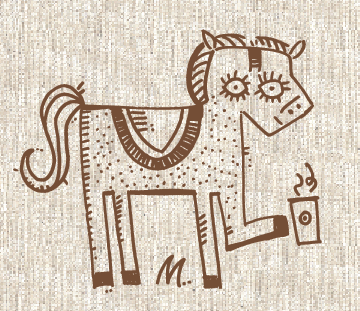 A great identity addresses basic human needs, attracting the equivalent of members to a club by projecting inclusion and the opportunity for affiliation. At Starbucks, a relationship is sold with every latte, an implicit membership to the club. And it’s all by design.
A great identity addresses basic human needs, attracting the equivalent of members to a club by projecting inclusion and the opportunity for affiliation. At Starbucks, a relationship is sold with every latte, an implicit membership to the club. And it’s all by design.
June 28th, 2010
Wake Up & Smell Search Engine Marketing
In 1998, Overture pioneered the idea of selling search ads. You could buy search results for as low as a penny or two per click. This system has quickly evolved into one of the worlds most competitive marketplaces.
Here’s a striking fact for you: among the five most visited websites in the world – two are search engines. The most visited site in the world is Google. 40 percent of every internet user in the world uses Google. 26 percent of every internet user visits Yahoo. Together, that’s almost 70 percent of every internet user in the world. 70 percent!
 So how can your business harness these goldmines of Internet traffic? It’s called Search Engine Marketing, and you should get to know it by first name: It’s SEM for short.
So how can your business harness these goldmines of Internet traffic? It’s called Search Engine Marketing, and you should get to know it by first name: It’s SEM for short.
SEM is direct-response and does not fall under the typical media umbrella. Strategy and media planning for these campaigns play a pivotal role. Preparing a direct-response campaign requires a greater deal of analytical thinking. With direct-response campaigns, not only does the client have quantifiable goals it seeks to meet, but those goals must be met within certain thresholds of often tightly controlled metrics to be deemed a success. Now to the finer details.
Pay-Per-Click Advertising
Pay-Per-Click (PPC) is a popular Internet advertising technique found on websites, online advertising networks and especially on search engines.
PPC Search Engine Marketing involves sponsored links that are typically in the form of text ads usually placed close to organic search results. A PPC advertiser pays a particular amount for each visitor who clicks
on these links or banners and lands on the PPC advertiser’s Web page.
In essence, PPC Search Engine Marketing is all about bidding for the top or leading position on search engine results and listings. PPC advertisers do this by buying, or bidding, on keyword phrases that are relevant to their products or services – the higher the bid, the higher the spot on the search results, the more the people will find the ad and click on it (this is why some people call it “keyword auctioning” or “keyword bidding”). PPC advertisers would then pay the bidding price every time a visitor clicks through the website.
Why Use SEM?
Because you’re smart. SEM is one of the most efficient forms of advertising around. It’s affordable, it’s testable and it gets results. If your company isn’t utilizing SEM right now, we need to talk. But it’s okay because the other beauty of SEM is that PPC advertisements can be implemented in a jiff. Still not convinced?
- Instant Traffic – no long waiting time and groups of hungry niche visitors are always searching for information everyday.
- Well-Targeted traffic with a broad reach
- By reaching out for well-targeted visitors who are already interested in your products or services, you can ensure a higher percentage of success in your campaign.
- Obtain specific, pre-qualified, and quality traffic.
- Increase additional traffic to your website, aside from the natural or “organic” search engines.
- Reach the masses
- Major players: Google, Yahoo!, Bing, Ask
- Smaller search engines: AltaVista (powered by Yahoo!), Netscape (powered by Google), AOL (listings come from Google)
- Your goals and results are tracked daily — giving you instant data on your investment
- Track exactly who comes to your website and what they do once they arrive – valuable in determining statistics such as ROI, cost-per-visitor and conversion rates.
- You only pay when users click on your ad
When you use large pay-per-click search engines you guarantee you are getting at least some good traffic, and that your business model is scalable. Smaller engines provide slower feedback loops, and some may not even provide quality traffic.
Tips & Tools
Use these quick tips when setting up a PPC campaign on any search engine.
- Analyze visitor search patterns and develop a list of relevant keywords visitors might use when looking for your products and services.
- Don’t cheap out. Popular keywords are expensive, less popular ones are cheaper. For best results, have a mix of both.
- Use precise ad copy. Clearly state the service / product you are promoting. If possible, include pricing if you are selling any product.
- Run multiple ads for the same words and test them against each other or send them to different pages to A/B split test your site or ad copy.
- Do not rush for position #1. Settle for positions 4/5/6 as bids will be lower and visibility will also be OK. This will lower your CPC and increase ROI.
Helpful References
Google AdWords Learning Center
The Google Keyword Tool
The Google Traffic Estimator Tool
June 28th, 2010
Ixnay on the Andbray
I have bad news. There’s really no way to sugarcoat it. I tried to start with an anecdote, a joke or an analogy. But I’m on my sixth rewrite and I’ve finally decided that it’s best if I just put it out there. So here goes: You have to stop using the word “brand.”
Put it on a shelf with your other favorites from the ‘90s. It should fit in the same box as your old Soundgarden cassettes, your Iomega Zip drives, and the three-ring binder full of TQM materials. There are a couple of reasons to let go of the word.
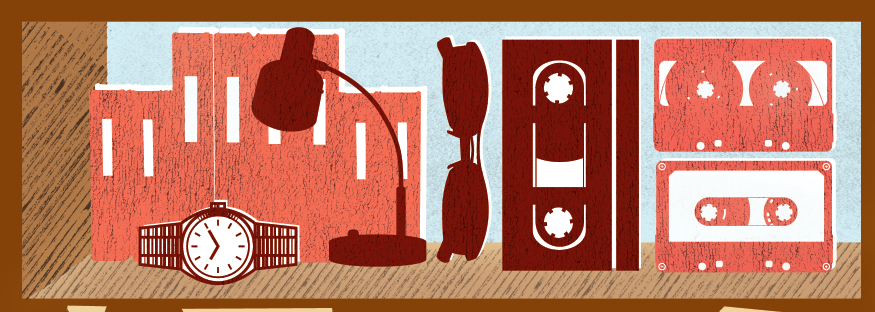
Reason 1: No one knows what you’re talking about.
You’re a marketing genius. You know exactly what you mean when you use the word “brand.” It is a concrete, concise and solid definition. It’s as obvious as if you were to say “tomato” or “dog.”
But that’s the problem.
To you, a tomato may conjure images of a ripe beefsteak. But the person next to you may think of an heirloom or a Roma. Dogs are relative, too. You may see a Chihuahua, while your neighbor sees a Great Dane. The same goes for “brand.” Some people think it’s a logo. Some think it’s an advertising campaign. Some think it’s a color palette and a specific font. Some think it’s shelf presence. Some think it’s the salesforce. Some think it’s a few of those things. Some think it’s all of those things and more.
No one’s wrong. No one’s right. Everyone’s confused. This wouldn’t be a big deal if we didn’t use the word “brand” as a strategic direction so often. But we do. When you ask for something that’s “on brand” or in “brand standards,” do you get what you were expecting? Probably not. Why? Because the word “brand” conjures a different definition in someone else’s head than it does in yours.
Reason 2: No one cares what you’re talking about.
That’s not true. It’s not that most people don’t care about your definition of “brand.” It’s worse. They hate you when you use the word. Your marketing peers may not be able to come to a definition, but your non-marketing colleagues have.
Immeasurable. Ineffective. Superfluous. Those are the big, polysyllabic words they use in public. Bullshit. That’s the word they use when they’re comparing “brand” budget to their departmental budget.
For a long time, the word “brand” was revered. The C-suite evangelized. The Marketing Department proselytized. Everyone else was hypnotized. They didn’t quite understand it. But whatever a brand was, there was a united front about its value and everyone needed to fall in line.
Eventually, though, they realized no one was talking about the same thing. People began to suspect that their marketing colleagues were simply throwing the word around to get their way and keep their budget: “This initiative is highly important to support our brand equity.” Or: “We can’t do that. That’s not on brand.” How many times have you heard things like that? Heck, how many times have you said stuff like that?
A few years ago, a silent-but-perceptible backlash against the word “brand” began to build in many organizations. People’s curiosity started to become animosity. The applause for brand-building became a golf clap.
Then the economy melted. And it didn’t matter that research proved companies who invested in their “brands” faired better during and after a recession. The pitchforks and torches were out. And so was the CFO’s red pen.
Now what?
This is an opportunity. Stop using the word and start asking questions. When a marketing colleague wants something “on brand,” ask them what they mean. Ask them to describe the very specific elements they’re looking for. Are they talking about colors and logo placement? Are they referring to language and tone? Make them think and explain. The irony: by using other words, everyone will begin to have a very clear understanding of what “brand” means in your organization.
And then there’s you. Don’t default to “brand” in conversation. Mention specifics. If something you’re doing needs a certain font or a certain attitude in the copy, say so. If you’re developing a new advertising campaign that’s more about the overall company than specific products or services, don’t call it a “brand campaign.” Call it a “corporate campaign” or an “overall campaign.” Say it’s “not product-specific” but is meant to “provide support for specific product initiatives.” Say whatever you want, just leave the word “brand” out of it.
That’s the other irony: by letting go of the word “brand,” you get to keep the brand itself. Even better? In the newest New Economy, you may also get to keep your job.
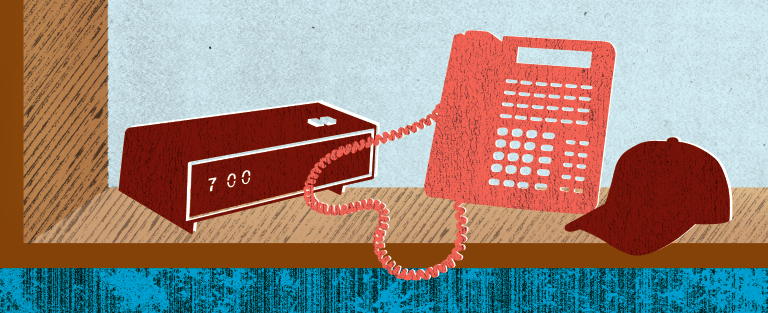
June 28th, 2010
Moms Wield Power
We’ve all instinctively known that since we were old enough to sass her. And the marketplace power of moms is nothing new to marketers, either. As household CEOs, moms control 85% of household spending and are worth more than $2 trillion to U.S. brands.
While moms have always been socially and politically active, their online savvy and growing organizational sophistication has expanded their market power and influence.
According to Nielsen, there are 32 million online Moms between the ages 25-54, who have at least one child under the age of 18.
That’s about 40% of all women online in the U.S. today and nearly 20% of the active online population overall.
With nearly 75% of moms with children under 18 working outside the home, they rely on technology to get things done. They use it to pay bills, order groceries, school shop, download coupons and hunt for ideas for their next family vacation. They also embrace technology to socialize, stay in touch and express themselves.
As social and communicative humans, moms have particularly embraced social networking with uncommon ardor, from Facebook to Twitter to mom-specific networks.
 Moms, more so than other consumers, depend on pals and peers for product recommendations. The web has given that word of mouth a massive dose of steroids. Yet, some marketers are slow to recognize how much moms really don’t like traditional, intrusive advertising. Moms are too busy to pay attention. You can’t summon them; you have to find them where they are. What’s more, they want and expect to engage in conversation.
Moms, more so than other consumers, depend on pals and peers for product recommendations. The web has given that word of mouth a massive dose of steroids. Yet, some marketers are slow to recognize how much moms really don’t like traditional, intrusive advertising. Moms are too busy to pay attention. You can’t summon them; you have to find them where they are. What’s more, they want and expect to engage in conversation.
Mom Bloggers are an increasingly powerful group which has given rise to networks like MomBloggersClub.com and TwitterMoms.com.
 Take the “Motrin Moms” incident. Some moms took offense at an online painkiller ad they believed portrayed mothers as shallow and slightly unglued. They quickly responded and took their thoughts online. Motrin took notice, apologized for the ad and removed it. The impromptu campaign got results — and the attention of mainstream media.
Take the “Motrin Moms” incident. Some moms took offense at an online painkiller ad they believed portrayed mothers as shallow and slightly unglued. They quickly responded and took their thoughts online. Motrin took notice, apologized for the ad and removed it. The impromptu campaign got results — and the attention of mainstream media.
 Same goes for “nursing gate,” when moms launched the “Facebook Sucks” campaign to get the social network to reverse its policy banning photos of breastfeeding mothers; mobilization was swift, huge and creative, leading to nursing videos on YouTube and even the formation of the Facebook group “Hey Facebook, breastfeeding is not obscene!” The group boasts close to 250,000 members and prominently features pictures of happy nursers — despite Facebook never officially reversing the policy.
Same goes for “nursing gate,” when moms launched the “Facebook Sucks” campaign to get the social network to reverse its policy banning photos of breastfeeding mothers; mobilization was swift, huge and creative, leading to nursing videos on YouTube and even the formation of the Facebook group “Hey Facebook, breastfeeding is not obscene!” The group boasts close to 250,000 members and prominently features pictures of happy nursers — despite Facebook never officially reversing the policy.
Marketers are beginning to realize they have to earn the trust of savvy online moms. They must move away from developing “messaging” to integrating “listening”. Listening to online discussions is as an ultra sensitive weathervane to hear the unexpected and to observe entirely new ways in which brands, categories and unmet needs may be expressed.
While marketers today have so many opportunities to connect with moms at various life stages (having a first or second baby, child entering school, return to work), the challenge is sensing her distinct needs and responding in a way that truly resonates. This forces marketers to redraw the vision of mom in our head.
Moms are far from a single, simple marketing segment. Factors like age, their child’s age and lifestage influence attitudes and behaviors.
Established moms:
between the ages of 40-50 with three or more children, are heavy online shoppers. They are more receptive to advertising deals and special promotions. They are heavy users of email and are starting to dabble in social networking with Facebook as the primary site. According to Facebook, this is the fastest growing user demographic.Newbie Moms:
aged 25-34 with one or two children at home, also enjoy online shopping, but social networking sites play a much more prominent role in their daily interactions. They’re more likely to use Twitter and to blog as a means to share their lives and express points of view.
For more information and links to research on moms, visit bozellthinking.com.







